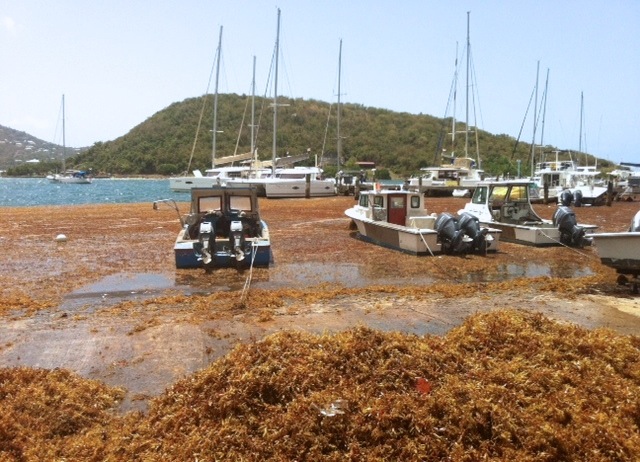Large deposits of Sargassum seaweed on coastal sites may seem drastic to several West African countries but converting this environmental challenge into economic gain is just one element of a three-point strategy experts are considering to win on both counts.

According to Wikipedia, Sargassum is a genus of brown macroalgae (seaweed) in the order Fucales. Numerous species are distributed throughout the temperate and tropical oceans of the world, where they generally inhabit shallow water and coral reefs, and the genus is widely known for its planktonic (free-floating) species.
“The United Nations Environment Programme (UNEP), therefore, challenge you experts here gathered to propose an adaptive management strategy of seaweed in West Africa,” Abou Bamba, the regional coordinator of the Abidjan Convention, said at the opening of the meeting in Freetown, Sierra Leone.
The Abidjan Convention Secretariat convened a three-day meeting that ended 13 November to debate the options. The experts were marine scientists, oceanographers, and policy analysts from the private and public sectors. They decided that the first action needed was to identify all the significant seaweed depositories in West Africa. Then, affected communities could be trained on transforming the weed into economically valuable items.
The experts may have been thinking of existing examples worldwide where a seeming seaweed menace has been used to economic advantage. In Namibia, which lies within the Abidjan Convention area, “Afrikelp” is dried, sold as fertiliser, and helps to hold soil. This brown seaweed, scientifically known as Ecklonia maxima, is the one that is washed up on the beaches of West Africa and Namibia.
In South Africa, the cold water seaweed Porphyra is used to feed abalone, a human edible mollusk which can also be used to make buttons, buckles and other decorative items. In Europe, brown seaweed has been used as animal feed. Seaweed extracts have been also applied to fruit, vegetable, flower crops and even cosmetics. It may be possible to use seaweed as fuel.
Such uses of seaweed offer livelihood possibilities to communities in the worst affected West African countries: Benin, Côte d’Ivoire, Ghana, Guinea, Liberia, Nigeria, Senegal, Sierra Leone, and Togo. These countries have asked the Abidjan Convention for help in dealing with the issue.
The Freetown meeting was the first response to that call for aid. The meeting accepted the broad plan of a three-prong regional strategy to exploit the Sargassum. Primarily, this strategy rests on establishing an early warning system to track the movement of the weed by satellite. The Abidjan Convention would have to rely on a partner able to provide this service. Making business out of the weed is the other prong of the strategy. It calls for identifying ways in which the Sargassum can be used locally, and training of communities in techniques for its transformation – the third prong.
The regional strategy also calls for establishment of an early warning system through use of satellites images, from GRID-Arendal and other partners, to inform coastal communities and national authorities on when the seaweeds would be washed ashore and their expected volume.
An important element of the strategy is the establishment of an information management system for the Sargassum. Although the meeting did not specify where this system will be housed, it might be feasible for universities and marine institutions in the region to feed data to the Abidjan Convention’s Ad Hoc Science and Technology Committee.
The strategy also calls for research into the biochemistry and physiology of the Sargassum; the establishment of a regional research facility to study the factors contributing to its spread; and a study on the social and economic impacts of the algae. Here, too, many universities and marine institutes in the sub-region could host this regional facility, without need to erect a specialized institution, and report through the Ad Hoc Committee of Science and Technology. The committee’s brief is to provide governments with science-based information and suggest courses of action to deal with the many marine and coastal environmental concerns to the region.
The regional strategy is supported by a broad set of recommendations. Among them is holding annual expert group meetings. At these gatherings experts would build knowledge on the Sargassum, exchange information, and encourage application of best practices in dealing with the algae. Presumably, though, such information sharing and increased knowledge can already be fed into the information management system and to a Science and Technology Committee, thereby sharing expertise amongst affected countries.
Each of the affected countries have been encouraged to obtain at least one seaweed clearing machine. This would clean up the beaches and collect the weed efficiently and make it easier to be transported to sites for conversion into useful commodities. It is this aspect in which the private sector is being encouraged to invest in the value addition process.
The causes for the unusual bloom in Sargassum are not known. However, the suspicion is that warming of ocean temperatures; increased levels of sewerage and marine litter discharge; increased maritime traffic and oil drilling activity may all be contributing or causal factors.
Holding together all interventions in solving West Africa’s Sargassum problem needs regional coordination. The Abidjan Convention provides that platform given it is the only existing political, legal and institutional regional framework for the Oceans that bring together the Atlantic coast countries of West, Central and Southern Africa. Therefore, the experts’ recommendation that an additional protocol of the Abidjan Convention be accorded on the Sargassum seems the logical next major step forward to ensure the operationalisation of a common regional strategy in the collection and management of seaweeds in West Africa. “We shall unlock the economic potential of Africa’s coast,” Bamba said at the close of the meeting.
